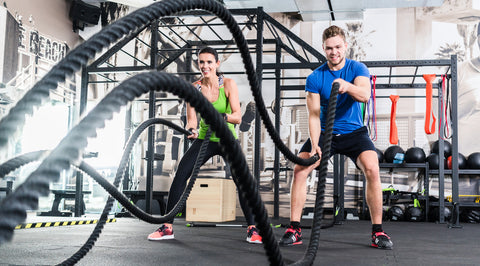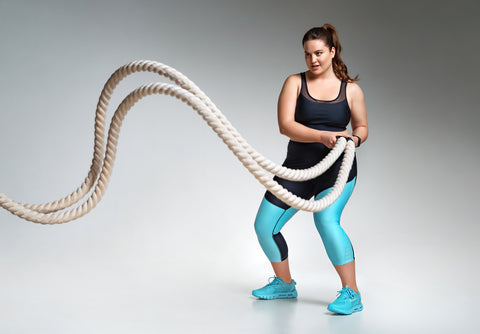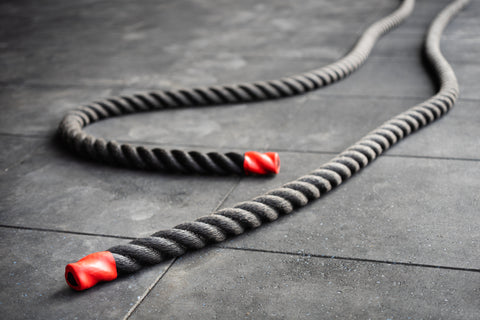Your cart is empty
Free shipping on all US orders


Free shipping on all orders

Battle ropes, also referred to as heavy ropes, have become a staple in both gym-based and outdoor fitness routines, offering a dynamic approach to strength and endurance training. Unlike traditional weightlifting, which tends to focus on isolated muscle groups, battle ropes engage multiple muscle groups simultaneously, making for a comprehensive workout that improves several aspects of health.
This versatile piece of equipment consists of thick, heavy ropes which you wave, slam, or whip in various patterns to create resistance. The beauty of battle ropes lies in their simplicity and the intense workout they provide, challenging both your upper body and core like few other exercises can.
But where did battle ropes come from? Their origins trace back to the early 20th century, initially utilized in specific branches of military training to prepare soldiers for the physical demands of service.

The ropes were valued for their ability to simulate the challenging, unpredictable movements soldiers might encounter in the field, improving their physical preparedness. Over time, this unique training tool caught the attention of fitness enthusiasts and personal trainers, gradually making its way into mainstream fitness by the early 21st century.
Intrigued to find out more? Let’s see what makes them so good.
Incorporating battle ropes into your workout routine can significantly enhance your physical endurance, offering a rigorous cardiovascular workout that pushes your body's limits. The continuous motion of swinging, whipping, slamming, or pulling the heavy ropes not only engages multiple muscle groups but also keeps your heart rate elevated, making it an excellent exercise for boosting endurance.
Endurance, in the context of physical fitness, refers to the ability of your muscles to perform a specific task without fatigue for an extended period. Battle ropes effectively train your body to sustain prolonged physical exertion, primarily through the mechanism of high-intensity interval training (HIIT).

When you perform rapid, intense bursts of battle rope exercises followed by short periods of rest, you mimic the HIIT protocol, which is renowned for its endurance-enhancing benefits. This type of training improves both aerobic (with oxygen) and anaerobic (without oxygen) fitness levels, conditioning your body to efficiently utilize oxygen and better manage energy stores during prolonged physical activity.
The dynamic nature of battle rope exercises requires constant movement and adjustment, engaging both the upper and lower body. As you wave, slam, or whip the ropes, your muscles face resistance both from the weight of the ropes and from the effort required to stabilize your body against the force generated by your movements.
This comprehensive engagement forces your heart and lungs to work harder to supply oxygen to the working muscles. Over time, this increased demand allows you to exercise longer and more intensely without tiring.
The versatility of battle rope exercises means that they can be easily scaled up or down in intensity, making them suitable for individuals at different fitness levels. Whether you're a beginner or an experienced athlete, adjusting the length, thickness, and weight of the ropes, as well as the duration and intensity of the exercises, allows for a customized workout that can grow with your endurance levels.
Battle rope exercises, not surprisingly, are a powerful tool for improving cardiovascular health due to their high-intensity nature. As you engage in these exercises, your heart is required to pump more blood to the muscles in use, to supply the necessary oxygen and nutrients needed for sustained activity. This increase in heart rate is one of the primary mechanisms through which cardiovascular health is enhanced.
The consistent and rhythmic movements involved in swinging, slamming, or whipping the ropes create a unique form of cardiovascular workout that combines both strength training and aerobic elements.
This dual approach ensures that the heart is not only working harder but also more efficiently over time. This is because the heart muscle, like any other muscle in the body, becomes stronger with regular exercise, enhancing its ability to pump blood more effectively throughout the body.
Additionally, the vigorous actions involved in battle rope workouts boost blood flow, prompting the circulatory system to enhance its adaptability and responsiveness. This advancement in vascular wellness aids in reducing blood pressure and lowering the risk of cardiovascular diseases, as it allows the arteries to more efficiently adjust their size to manage blood circulation.
Regularly incorporating battle rope exercises into a fitness regimen can also lead to significant improvements in metabolic rate. As the body works harder to maintain the intense activity level, it burns calories at a higher rate, which can contribute to weight loss or maintenance. Since excess weight is a risk factor for cardiovascular disease, the calorie-burning aspect of battle rope workouts further supports heart health.
Who would have thought that battle rope training could enhance coordination and balance? This improvement is largely attributed to the multifaceted nature of the movements involved in battle rope workouts, which require a coordinated effort between various muscle groups and the nervous system.

The mechanism behind the enhancement of coordination and balance through battle rope exercises begins with the requirement for constant stabilization. When performing exercises such as waves, slams, or spirals, the body must engage both the core muscles and those of the lower body to maintain stability and posture.
This engagement is crucial because the dynamic and often unpredictable movement of the ropes demands quick adjustments from the body to remain balanced. Over time, this repeated need for stabilization not only strengthens the muscles but also improves proprioception—the body's ability to sense its position in space.
Battle rope exercises also necessitate a high degree of bilateral coordination. Many exercises require the simultaneous but opposite movement of the arms, which challenges the brain to coordinate complex movements.
This bilateral coordination is essential for daily activities and sports, where synchronized movements of different body parts are required. As the nervous system adapts to these demands, improvements in overall coordination are observed.
Battle rope exercises are also known to introduce an element of unpredictability due to the free movement of the ropes. This unpredictability requires quick reflexes and adjustments, further training the body and mind to work together to maintain balance and coordination.
As these skills improve, you may find enhanced performance in other physical activities and a reduced risk of falls and injuries, owing to improved balance and coordination.
Building muscle and strength involves a fascinating sequence of biological processes, primarily hinging on the principles of muscle hypertrophy and neural adaptations. Muscle hypertrophy is the increase in muscle size, which occurs as a result of strength training through activities such as resistance training. This process begins at a microscopic level within the muscle fibers.
When muscles are subjected to stress, such as lifting weights, the fibers experience microscopic damage or tears. This might sound detrimental, but it's actually the catalyst for muscle growth.
The body responds to this microtrauma by repairing the damaged fibers through a cellular process where it fuses muscle fibers together to form new myofibrils (muscle protein strands). These repaired myofibrils increase in thickness and number to create a state of muscle hypertrophy. Over time, this process results in larger and stronger muscles, as the muscle fibers become more efficient and capable of handling increased loads.
In parallel with these structural changes, there are significant neural adaptations that contribute to strength gain. When you first begin to lift weights or use battle ropes, the initial strength gains are largely attributed to these neural adaptations rather than an increase in muscle mass.
The nervous system becomes more efficient at recruiting motor units (groups of muscle fibers controlled by motor neurons). It learns to activate them more synchronously, which improves muscular coordination and increases the force that muscles can generate. There's also an increase in the firing rate of motor neurons, which contributes to greater muscle force generation.
Hormonal responses are equally as important and play a critical role in muscle growth and strength development. Training with these ropes stimulates the release of growth hormone and testosterone, which are essential for protein synthesis and muscle repair. These hormones not only help in building muscle mass but also in reducing fat, which can further enhance muscle strength and appearance.
To fast-track these gains, supplementation with creatine can lead to appreciable accrual of strength and muscle mass. Try Foundation; our blend of creatine and Peak ATP to take your performance to the next level.
When you're looking to boost your mental health and reduce stress, incorporating battle ropes into your fitness routine might not be the first thing that comes to mind. However, this dynamic and physically aggressive exercise can offer more mental health benefits than you might initially think.
Utilizing battle ropes demands complete focus and effort, offering a reprieve from continuous stress-inducing thoughts as you immerse yourself in the exercise. The act of concentrating exclusively on the workout's movement, rhythm, and force serves as a kind of active mindfulness. By staying present in that exercise, you temporarily halt stress and anxiety, allowing your mind to relax.
The rigorous effort required to maneuver those ropes not only fortifies your physique but also initiates a series of neurochemical shifts within your brain. Engaging in a session with battle ropes prompts your body to release endorphins, commonly known as the 'feel-good' hormones. These natural mood enhancers are crucial in diminishing stress, easing anxiety, and promoting a sense of wellness. It's similar to the euphoria experienced after running, but with battle ropes, this sensation is attained through intense, brief spurts of activity.
Beyond the biochemical, engaging with battle ropes can also boost your mental health by enhancing your self-esteem and confidence. Each session presents an opportunity to push your limits, set new personal records, and achieve visible progress.
This sense of accomplishment and the physical improvements that come with regular practice—such as increased muscle tone, strength, and stamina—can significantly elevate your self-image and confidence levels.
Additionally, using battle ropes provides an excellent means for releasing built-up frustrations and aggression. The vigorous action of swinging the ropes can serve as a powerful emotional release, offering a constructive outlet for dissipating negative emotions and stress.
This physical exertion of energy aids in clearing the mind, diminishing feelings of anger or frustration, and enhancing one's overall mental clarity and tranquility.

Begin by holding the ends of the rope with both hands, feet shoulder-width apart. Start creating waves by alternately raising and lowering each arm. Keep your core engaged and maintain a slight bend in your knees. Focus on the fluidity of your movements, aiming for consistent waves.
The slam is a powerful move that targets your core, shoulders, and arms. With feet shoulder-width apart, lift the rope high above your head before slamming it down to the ground with full force. Ensure you squat down as you bring the rope down, engaging your legs and core throughout the movement.
A variation of the slam, the power slam requires you to use both arms simultaneously. This exercise demands more energy and engages your entire body, making it a fantastic way to build power. Remember to keep your back straight and use your legs and core to generate force as you slam the ropes down.
Similar to the basic wave, this exercise involves moving your arms up and down alternately, but at a faster pace. The goal is to keep the ropes moving smoothly and quickly, which will elevate your heart rate and improve your endurance. Keep your knees slightly bent and your core engaged throughout.
Start with your feet together, holding the ropes. Jump and spread your feet apart while simultaneously moving your arms outwards to create a wave. Jump back to the starting position, bringing your arms back in. This exercise is excellent for improving coordination and engaging multiple muscle groups.
Once you've mastered the basics, it's time to challenge yourself further by trying these advanced techniques.
Combine the double wave with a jump squat for a high-intensity workout. Perform a double wave, then immediately follow with a jump squat, ensuring you land softly. This combination is excellent for building explosive power and endurance.

Stand perpendicular to the rope's anchor point and swing the ropes sideways, creating lateral waves. This move targets your obliques and helps improve your lateral movement agility.
Think burpees were hard enough? Think again. Add an intense twist to the classic burpee by incorporating battle ropes. Perform a burpee, and as you jump up, grab the ropes and perform a double wave. This exercise is a full-body workout that blasts your cardiovascular fitness and boosts muscle endurance.
Incorporate a reverse lunge into your power slam for a compound exercise that challenges your balance and coordination. As you step back into a lunge, perform a power slam, engaging your core, glutes, and legs.
When it comes to enhancing your workout routine, incorporating battle ropes can be a game-changer. However, with various options available, you might find yourself pondering over which battle ropes are the right fit for your fitness goals, especially since there isn't a singular one-size-fits-all approach.
Here are some things to keep in mind.
The length and thickness of the battle rope you choose will significantly impact your workout. Hence, it is a consideration you need to prioritize. Generally, battle ropes come in lengths ranging from 30 to 50 feet. If you're working in a smaller space or are a beginner, a 30-foot rope might be more manageable and versatile for various exercises.

On the other hand, a 50-foot rope can provide a more challenging workout, especially for cardiovascular and strength training, due to its heavier weight and the greater force needed to create waves.
In terms of thickness, battle ropes typically range from 1.5 to 2.5 inches in diameter. A 1.5-inch rope is easier to grip, making it a suitable choice if you're new to battle rope workouts or have smaller hands. A thicker rope, such as a 2.5-inch variant, requires more grip strength and can significantly enhance your grip training while also engaging your muscles more intensely.
When selecting a battle rope, you'll encounter options made from various materials like manila hemp, poly dacron, and nylon. Manila ropes, made from natural fibers, offer a traditional feel and are quite durable but can be rough on the hands and susceptible to shedding.
Poly dacron ropes, a popular choice, are known for their blend of durability and smoothness, providing a comfortable grip without compromising on the challenge they present. Nylon ropes, while less common (and more expensive), are soft to the touch and highly durable, making them an excellent option for indoor use.
An often overlooked but vital component of selecting the right battle rope is considering your setup, specifically the anchor point. Ensure that you have a solid and stable anchor point that can withstand the dynamic and forceful movements battle ropes require.

Some ropes come with anchor kits, but you can also purchase an anchor separately or use existing structures like heavy gym equipment or posts, provided they are stable and won't be damaged by the rope.
When setting up your rope, ensure there's enough space for the rope to extend fully without any obstructions. This will allow you to perform a variety of exercises effectively.
The surface you're working on will also influence your choice; for instance, if you're working out on a rough surface, you might prefer a rope with a protective sleeve to prevent wear and tear.
Despite the numerous benefits of using battle ropes, certain common mistakes can significantly hinder your progress and potentially lead to injuries if not addressed. By being aware of these pitfalls and knowing how to correct them, you can maximize the effectiveness of your battle rope workouts while ensuring safety and longevity in your fitness journey.
This is perhaps the most common, and one of the first mistakes you might encounter, involving how you grip the ropes and position your body. An incorrect grip or stance not only reduces the efficiency of your workout but also increases the risk of strain and injury.
You might find yourself gripping the ropes too tightly, causing undue stress on your hands and forearms, or adopting a stance that is either too wide or too narrow, impacting your balance and the power of your movements.
Battle ropes heavily engage the upper body, but over-relying on your arms and shoulders can lead to imbalances and overlook the potential full-body workout benefits of the ropes. Overusing the upper body not only limits the effectiveness of the exercise but also puts you at risk of overwork, and injuring these muscle groups.
Another common mistake is neglecting the importance of proper form and technique. This oversight can significantly diminish the effectiveness of your workout and increase the likelihood of injury. For example, slouching, not fully extending your arms, or using only small, limited-range movements reduces the workout's intensity and its benefits.
Absolutely, incorporating battle rope exercises into your fitness regimen can be a game-changer when it comes to weight loss. These dynamic movements elevate your heart rate, engaging both your upper and lower body, which maximizes calorie burn. The constant motion provides a high-intensity workout that can help shred fat and build lean muscle, contributing significantly to weight loss efforts.
If you're a beginner, starting with shorter sessions is key to avoiding overexertion and injury. Aim for intervals of 15-20 seconds of intense activity followed by 45 seconds of rest, repeating for about 10 minutes. As your endurance and strength improve, you can gradually increase the duration and intensity of your workouts.
When it comes to equipment and attire for battle rope training, comfort and safety are paramount. You don't need any special shoes, but it's advisable to wear sturdy, closed-toe athletic shoes to protect your feet. Gloves can also be beneficial to prevent blisters or calluses on your hands. Make sure the area around you is clear to avoid tripping hazards, and that the surface you're on provides enough grip to maintain your footing during exercises.
Incorporating battle rope exercises into your routine 2-3 times per week can offer substantial benefits without leading to overtraining. This frequency allows your body ample recovery time while ensuring you're consistently challenging your muscles and cardiovascular system.
For seniors or those with mobility issues, battle ropes can still be a viable option, albeit with modifications. Opt for lighter ropes and focus on movements that don't require high levels of agility or balance. Always consult with a healthcare provider or fitness professional to tailor exercises to your specific needs and capabilities.
To prolong the life of your battle ropes and prevent them from fraying or getting damaged, store them properly when not in use. Avoid leaving them on abrasive surfaces like concrete, and consider using a rope protector or wrapping the contact points with tape. Regularly inspect your ropes for signs of wear and tear, and replace them as necessary to ensure your safety during workouts.
What do you think? Are the ropes something you’d like to try? We support them. They could make a difference in an indifferent workout and help you to break through training plateaus.